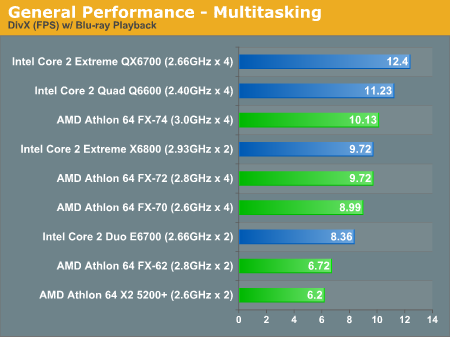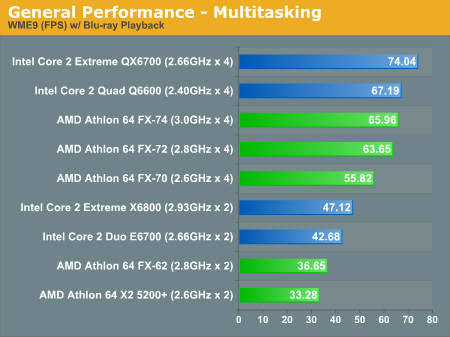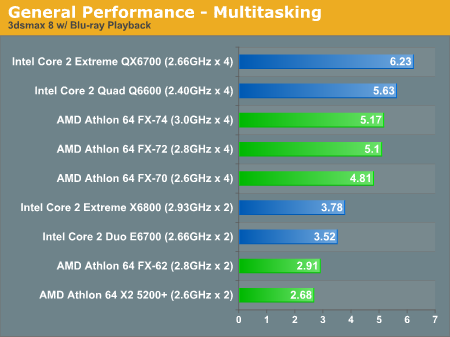AMD's Quad FX: Technically Quad Core
by Anand Lal Shimpi on November 30, 2006 1:16 PM EST- Posted in
- CPUs
Multitasking Performance
When we were trying to think up new multitasking benchmarks to truly stress Kentsfield and Quad FX platforms we kept running into these interesting but fairly out-there scenarios that did a great job of stressing our test beds, but a terrible job and making a case for how you could use quad-core today.
Without a doubt, in the next two years the number of applications that see a benefit when running on four cores will increase dramatically. Even multitasking under Windows Vista will make the argument for more cores easier (simply opening a new Explorer window in Vista will eat up 10% of the CPU time of a Quad FX system), but our Vista benchmarks are not yet complete and we wanted to have something to showcase for this review.
While working on our Quad FX article we also happened to be working on a follow-up to our HDCP Graphics Card Roundup, focusing on H.264 decoding performance in Blu-ray titles. A light bulb went off and we had our benchmark: how many cores do you need to watch a high bit-rate Blu-ray movie and do something else at the same time on your PC?
The movie we used was Xmen III, encoded in H.264, and featuring bitrates in excess of 40Mbps at times. Our benchmark starts at the beginning of Chapter 18 and continues until our background tasks are complete. This particular segment ranges in bitrate from 13Mbps up to above 40Mbps, with the average falling in the 18 - 24Mbps range.
We played the movie in the foreground, while in the background we either ran our Cinebench test, encoded a DivX movie, encoded a WME9 movie or performed our 3dsmax test.
The two rendering tests are important because rendering can take a bit of time and it might be nice to entertain yourself with a movie while your rendering completes; after all, what's the point of having $1000 worth of CPUs if you can't use them for entertainment?
The two encoding tests are also important because being able to encode and decode at the same time is a fundamental requirement for a DVR, and at some point the next-generation of media center PCs will need to be able to decode high bitrate HD movies while encoding others. We chose to include both DivX and WME because DivX runs much better on Intel CPUs, while the standings are a bit closer under WME, to give you a better overall impression of how the two platforms handle these heavy multitasking scenarios.
Our first test involved us playing back the BD title while running our multi-threaded Cinebench test; we reported the Cinebench score upon its completion:

The dual core processors all fall to the bottom of the list and basically perform like single-core CPUs while decoding the Blu-ray movie. The quad-core setups do much better and perform very well, but all of the CPUs in this test were able to run without dropping any frames in the BD movie.
Making things a bit more difficult, our next test had the same movie playing back but this time we ran our DivX encoding test in the background. We reported the DivX encoding frame rate upon completion:

Performance is pretty much what you'd expect, although Intel's superior DivX encoding performance results in the Core 2 Extreme X6800 doing almost as well as the FX-74. What you don't see however is how well these systems played back the Blu-ray movie; none of the dual core setups were able to play the BD movie smoothly, not even the Core 2 Extreme X6800. The movie was basically unwatchable due to all of the pausing and stuttering.
All of the four core systems played the BD movie fairly well; although they all dropped some frames, it wasn't enough to totally ruin the experience.
Next up we tried playing our BD title while running our WME9 test, and found similar results:

Once again, none of the dual core platforms were able to play the BD title even remotely smoothly. The quad-core setups were able to play the movie while encoding, but still managed to drop some frames (not enough to ruin the experience though).
Our final multitasking test has us playing the same BD title while running our 3dsmax 8 render test:

Much to our disappointment, none of the systems could handle this workload without ruining the movie playback; even the quad-core setups had troubles. We're not talking a few dropped frames, but rather the movie playback would be completely stopped at times. It looks like we may have a scenario for either more GPU assisted H.264 decode or an 8-core Quad FX platform in the future.










88 Comments
View All Comments
VooDooAddict - Saturday, December 2, 2006 - link
It strikes me as odd that you haven't reviewed a Dual Xeon 5300 system.While the motherboards aren't geared toward the enthusiast. It would seem anyone who could really benefit from two Dual core Athlon FXs would get incredibly more bang for the $$ out of a Dual Xeon 5300 system giving them 8 cores on an established and sure to be supported platform.
I only see two major drawbacks to the Dual Xeon as opposed to 4x4.
You don't have access to SLI. That's unimportant though as people who want SLI would be better served with an Intel QX6700 on an NVIDIA 680i.
You need FB-DIMMs. Considering the expense you are already at with any Dual CPU system, and the types of activities you'd need to be doing to get real benefit. ECC probably wouldn't be a bad thing to have.
I'd love to see a review of a Xeon 5300 System with a 8800GTX.
yyrkoon - Friday, December 8, 2006 - link
To the best of my knowledge ECC memory is usually slower compared to non ECC memory. Also, if I didn't read it here, I read it somewhere else, not only is FB-DIMM memory more expensive, it also does not perform as well compared to standard DDR2 memory.I think, for now, if you're wanting the best of both PC/server worlds, you would have to settle for a motherboard similar to Asus' Workstation, or Pro line. However, you would still be stuck with a single CPU, with multiple cores, but you would have SLI, PCI-X, and 2-3 PCI 2.3 slots :) As for memory quantity, anything more than 4 GB on a 32 bit OS is a waste (unless you use the right OS with the equivalent of the /PEA boot option, which I understand can cause some system instabilities)
yyrkoon - Friday, December 1, 2006 - link
As far as I can remember, using multiple CPUs (as in socket, not core), has always shown diminishing returns. In fact, I think I remember reading something to that effect here on this web site (or maybe it was TH?). Regardless, having several Dual CPU boxen around, and have had the chance to play around with a few Quad CPU systems, I've seen this with my own two eyes.I did not start reading this article with the belief that AMDs solution would beat an Intel quad setup, but I did have hopes that AMDS system would be at least feasible. The way I see it, from these results, AMD should have never even bothered with this design, and would have better spent their time working on future technology.
A few more mistakes like this, and pretty soon the only choice we're going to have is Intel, and it doesn't matter which company you buy from. We all should be hoping this never happens. My current system right now, is an AM2 system, and I have to say, I'm a bit miffed at AMD for leaving customers like myself out in the cold, when it comes to performance CPUs. So now, since I spent less than $200 for my current Motherboard / CPU, I think I'll Leave AMD in the dust (before they get the chance to do the same to me), and opt for an Intel system board, and CPU, for my next upgrade.
stepz - Sunday, December 3, 2006 - link
To be fair, the engineering effort was close to zero. They sell almost exactly the same stuff as Opterons, only in shinier boxes and surrounded by a lot more nonsense buzzwords. This product is brought to you mainly by the marketing department.
fitten - Friday, December 1, 2006 - link
Amdahl's Law.
T Rush - Thursday, November 30, 2006 - link
I'm really not that thrilled to see a brand new Intel CPU barely squeak by a similar config from AMD that is using a CPU architecture that is over 4 years oldI just gave Anand Lal Shimpi's article a closer inspection, we do see an advantage to the new Intel Core2 Q 65nm Kentsfield, but its not as large as I think it should be compared to the AMD64 90nm K8/Hammer dual cores times two...and however the pricing also doesn't reflect the large advantage you would expect to find with a newer more efficient design: as tested the two FX-74's are priced the same as the Extreme QX6700, and then next we see that two FX-72's under pricing the coming Quad Q6600 by a noticeable amount, and last we don't see a Quad Core2 to compete with the two FX-70's at the lowest $599 for the pair...I would expect the newer tech to not only be a much better performer, but also less expensive as well
....but to my surprise Shimpi almost caused me to fall out of my chair when I got to the last page and one of his biggest complaints was the higher price of the competition's motherboard!!!!, this to him seems to be a problem for AMD now, but the Intel systems he has tested before he was willing to overlook....here with this comparison he has a problem with the total system cost(mobo+cpus) being higher do to the motherboard being over one third more expensive as tested; $370(which he later even 'rounds up' to $400) for the AMD vs. $260 for the Intel, looking at $110 difference
....oddly with even his own widely revered "Tremendous Value Through Overclocking" that he wrote, where the focus is in fact "Value"(not something that I would think is "as big" of an issue when looking at the highest priced/performing/featured/etc. systems that you could possibly buy today) he completely was not bothered by the fact that he was using a $250 motherboard for the "Value" Intel CPUs at as much as $120 difference more to the $130 AMD board he used where value was a factor in that earlier case ..what!!!
fitten - Friday, December 1, 2006 - link
Well... the parts that "barely squeak by" are also running at only 80% of the clock frequency... 2.4GHz Q6600 compared to 3.0GHz AMD FX... and Intel's Core2 architecture seems to have plenty of headroom to go to higher clockspeeds on Intel's whim... 3.6GHz overclocks are pretty common with the Core2Duo parts (and the Quad parts are the same exact cores).There's no doubt that the Core2 architecture from Intel is the largest CPU performance bump in a number of years... previous years were almost stagnant as we saw 200MHz to 400MHz clock frequency increases on the same cores as the previous year. Core2 was a performance jump that was similar to the days of the Pentium3 timeframe.
T Rush - Thursday, November 30, 2006 - link
was anyone really expecting AMD's "4X4" system using two CPUs built using the 4 or 5 year old K8/Hammer CPU architecture to out-perform Intel's latest release using its newest recent Core2 architecture?...I would hope not...if anything Intel should have been able to pull off a much larger victory in price and performance....where the only clear major advantage that shows the large difference you would expect to see when comparing very new tech to much older was with the power consumption, which I wouldn't think is that great of concern with any system that is running four cores and most likely dual high end video cards(or more) in a "all out" highest performing/benchmarking gaming desktop system
the over all win does go to the Intel on this dual dual core battle..but personally I would have liked to of seen a much broader margin before putting all my eggs in one basket as many will do
cryptonomicon - Friday, December 1, 2006 - link
Thats an incredible amount of power... 450w!! Now that's what I need to keep my room warm this winter :DJarredWalton - Friday, December 1, 2006 - link
You can overclock an E6300 even higher on a lot of P965 boards than on the $225 ASUS P5W DH. The motherboard chosen was used for consistency in benchmarking, not because it is the recommended "budget overclocking" motherboard for socket 775. As for QX6700 barely outperforming FX-74, there's a couple of things to keep in mind. First, you can't buy the AMD chips yet, whereas QX6700 is actually available (albeit a bit expensive). Second, the past indicates that 3.0 GHz is pretty clearly to limit of AMD's current chips on 90 nm.Meanwhile you have QX6700 systems shipping factory overclocked at 3.33 GHz and beyond. Sure, with that level of overclocking, the power draw might actually begin to be similar between the two platforms. However, a 25% overclock of a Core 2 Quad certainly isn't going to close the margins. And given that these are indigenous platforms we are talking about, overclocking is going to be far more common than not I would say.
I'm not sure on Q6600 pricing either (since it's not available), though I've heard at least one rumor suggest the price has dropped to around $500. Guess we'll wait and see there as well. Basically, we are see Core 2 Quad beat AMD's latest and greatest in almost every test, without even pushing the clock speed limits. In seven months, we can evaluate again, and maybe AMD will have the lead.
Basically, we should expect the margin of victory to be slightly lower with a single socket quad core going up against dual socket dual core then it was with Core 2 Duo going up against Athlon X2. The dual sockets give more memory bandwidth, so particularly when running a NUMA aware operating system, things should be pretty close when comparing FX-74 against QX6700. AMD was basically able to close the performance gap somewhat by throwing more power and hardware at the problem, sort of similar to what Intel did with Pentium D. It wasn't a good solution when Intel did it, and it's not a good solution now. It is "OK" at best.